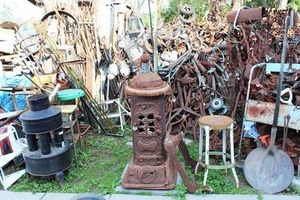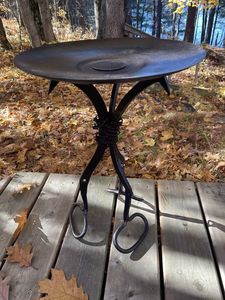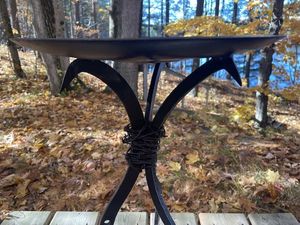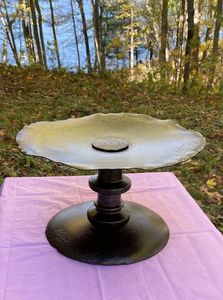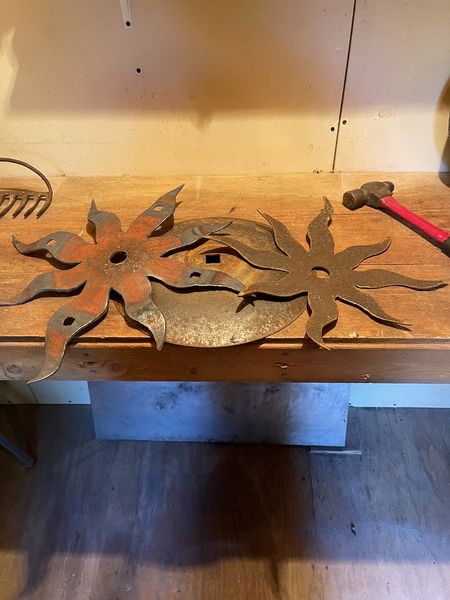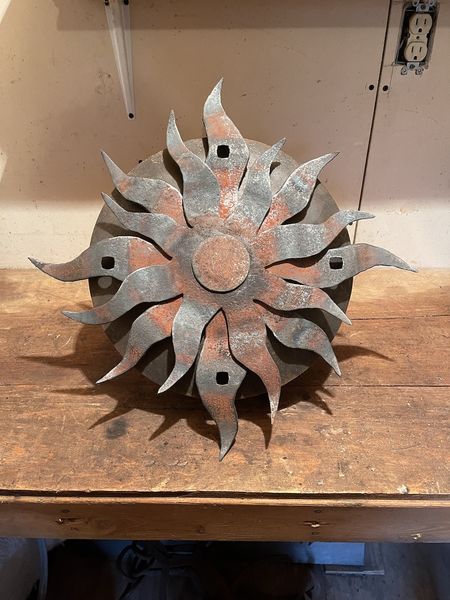Rusted Development
By Lorrie Potvin
For decades I’ve been cruising antique haunts and farm fields, stopping at those laden with dormant pieces of rusted equipment - harrows, cultivators, thrashers, sickle bars among them. I’m drawn to the strength and beauty of these worn pieces of rusted gold. Even if irrelevant, and unable to marry modern tractors, I’m grateful they haven’t been discarded or hauled off for the value of their scrap.
Farmers are some of the most resourceful folks I’ve ever met. They are welders, machinists, fabricators, handy people who can “MacGyver” solutions to most problems that arise when working and tilling the land. And they never throw anything out. Instead, they park old equipment in boneyards or beside the off-kilter barn at the edge of the back pasture.
A few years ago, I approached my neighbour about a cultivator with S-tines I’d noticed beside a fence near the county road that fronts his acreage. I had an idea of using three tines to support a harrow disc, a bird bath, possibly a plant holder. He took a moment, pondering my request, literally rubbing his chin, “hate to part with that cause ya just never know what ya might need or when ya might need it.”
Time for Plan B. Let’s call it a stand. I found the legs for it while scrounging through Rideau Antiques on Rideau Ferry Road. It’s a place a person needs to experience rather than being told about. There are five-foot-high rows of mounds of stuff, anything you can imagine having been made of metal, stacked at precarious heights circling the house and its outbuildings, which are also stuffed to exploding with artefacts. I’ve felt the house’s strain, the heaviness of its burden when I explored its rooms and halls, which are more like tunnels forcing visitors to single file, tip toe from one space to another. Like if one foot was placed too heavily in the wrong place the house would topple on itself.
Surprisingly, there was some organization to the overabundant chaos, but the excessiveness of it all made me wonder what’s at the bottom, in the middle of the piles? A hidden gem, the piece that inspires but will never have a chance?
Luckily, I found the legs to my plant stand on top of a pile near the outdoor checkout shack. It was put up to survive Covid. I picked two similar sized ice picks. Beautiful, old steel, fashioned by hand and hammer. The handles had been forge-welded, a practice thousands of years old, long abandoned by modern production lines.
After dismantling and wire-brushing the picks, I chose three to work with. To re-shape the curves and handles, I heated the metal using my torches to make it easier to bend. Once happy, I chose a good-sized harrow disc for the top. Harrows come with centre openings. To cover it (just in case someone chooses to use it as a bird bath) I cut out a small circle from another disc using my plasma arc cutter and bronze welded it in place. This harrow came from a family farm on Canoe Lake Road in South Frontenac. My luck was that the family was in the business of selling used equipment.
Harrow discs are made from extremely hard spring steel to prevent bending while being dragged through the fields. They are more likely to lose diameter, or break from being too hard, than bend. As a welder you pick up on these properties from the type of sparks released when grinding or welding.
I fitted up the final piece, bending its parts to fine tune the design. When I was satisfied, I marked the mating surfaces where I needed to grind and clean for welding. After turning off my welder I stepped back and pondered. The stand needed something more to bring it together. My thoughts went to a bundle of rust, a coil of barbed wire I found while walking my neighbour’s property, a large tract of forest now under Conservancy. The coil was whole, unspun. Its appearance was a complete mystery. No fences, no livestock, no disputes, nothing to explain its existence. If I had more of a word count I’d love to make up a deeper story here – it's dark, a figure limps through the forest, stops to rest against a tree, sweaty, chest heaving, looks back, lights flicker, twigs break, they push off, hands slipping on the bark, something bites their ankle, they fall into a woven web of barbed wire, a nest that has been staked to the ground . . . waiting.
Thank you for indulging me. I used a length of the barbed wire to wind around the middle of the stand, both covering the welds and adding to the ‘edginess’ of the piece. It’s one of two stands I’ve made so far from ice picks, and they rank among my favourite pieces.
Your CanLit News
Subscribe to Open Book’s newsletter to get local book events, literary content, writing tips, and more in your inbox
Also a favourite, is a table centrepiece assembled from two harrow discs and a spacer used as a bearing to hold the connector bar. The same bar I used for Sharon’s Bench. The carriage bolt used to tie the discs together came from a box of hardware at the REAL Deal Reuse Store in Smith’s Falls. The top disc is beautifully bent, and it’s hard to imagine the force, the horsepower required, real and mechanical, it took to bend its circumference. I’ve tried to re-create this damage, I’ve gotten close, but a person can still tell a set of torches and hammer was involved.
My scheme of rusted development is to offer the creation story of the pieces I make. An enrichment. I imagine those stories being retold by people enjoying tea in the garden, or over glasses of wine at a dinner party. What are their experiences and imaginations adding to the tales? How far will the stories travel and how will they morph over time? Because that's what stories do. Stories are life, and when I think of being stripped of all that I have, only my words will be left. And words create stories, and stories create life, places, culture, and people. A re-abundance.
See below for a little sunshine!
* * *
The views expressed in the Writer-in-Residence blogs are those held by the authors and do not necessarily reflect the views of Open Book.
Tradeswoman, artist, writer, and teacher Lorrie Potvin, a queerishly two-spirited Métis, is the author of Horses in the Sand: A Memoir. Her first book, First Gear: A Motorcycle Memoir and the essays "My tattoos speak of life and loss" and "Why I’m thankful for multiple sclerosis" (The Globe and Mail), were published under her previous surname Jorgensen, as was the short story, "The 13th Dock" in Writing At Wintergreen, an anthology edited by Helen Humphreys.
Working and teaching in the trades for over 30 years, Potvin holds an Inter-Provincial Red Seal in Auto Body Repair and Refinishing from Algonquin College and a diploma in Technological Education from the Faculty of Education, Queen’s University, with additional qualifications in Manufacturing and Special Education. A citizen of the Métis Nation of Ontario, Lorrie lives on a lake north of Kingston in the area served by the High Land Waters Métis Council where she’s lived for 30 years, building her home and creating art made of stone, wood, hide and steel.
